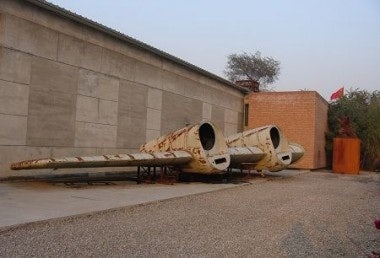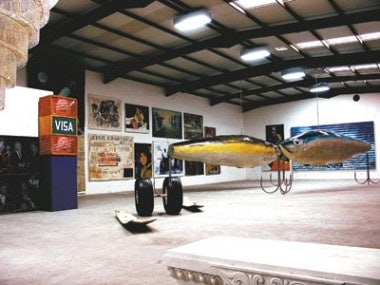Guan's "Warehouse" Contains Hundreds Of Important Pieces By Top Chinese Artists#

The Chinese magazine Mangazine (精英男性杂志) recently profiled the Chinese contemporary art collector Guan Yi (previously on Jing Daily), who -- along with other mainland Chinese "super-collectors" like Liu Yiqian -- hopes to gradually leverage his passion for collecting to benefit arts education in China and document the development of Chinese contemporary art over the past 30 years. From Mangazine (translation by Jing Daily team):
On April 20, 2006, when Hu Jintao was visiting the United States, the New York Times ran an article that included Guan Yi's photo alongside works of art, calling him one of the new contemporary faces of China. In early 2008, the important American art magazine ART+AUCTION compiled a top 10 list of the "world's art authorities," which included Guan Yi. Clearly, Guan's reputation precedes him. Since Chinese contemporary art hit the auction world 10 years ago, Guan Yi's image and interviews have appeared in the domestic and foreign press, making him the representative of more than 1 billion Chinese when the outside world wants our perspective [on contemporary art].
But finding Guan Yi isn't actually that difficult. It seems that anyone who's involved with making art, writing about art, selling art and every organization has his mobile number. Recently, if an important art exhibition or auction is being held, Guan Yi will be there. And anywhere he appears will later hold an important art exhibition or auction. If you appear standing next to him, you'll become important. In the eastern suburbs of Beijing, in the Songzhuang art district, Guan has his own territory, concealing more than 10 years of Chinese contemporary art that traces the path of this artwork's development.
Guan Yi was born in the '60s, and like many of the artists who grew up in that area he holds pure cultural ideals. In the '80s, he was even something of an avant-garde artist himself. The logo of the 1989 China contemporary art exhibition -- the "No U-Turn" sign -- hangs behind his headboard. In 1993 Guan started running a business. But still, driven by his personal philosophy and rabid passion for art, he later returned to the art world. Before that, aside from in the company of business acquaintances or family members, Guan rarely mentioned his love of art.
After returning to the art fold around 2000, Guan Yi has put no limitations on his art collection. In 2001 he established the "Guan Yi contemporary art museum," with his collection being referred to by Westerners as "the best way to understand Chinese contemporary art." In 2002, Guan collected his first installation work, Huang Yong Ping's "World Factory" -- a colossal 260 square meter rendering of the Chinese map made of metal bars. Between 2003-2005, Guan Yi collected a series of works by Huang that range from 1985-2005, 16 works in all. Soon, he had become Huang Yong Ping's top collector.
Apart from Huang Yong Ping, Guan Yi has also collected a number of works by artists like Cai Guo-Qiang, Gu Dexin, Wu Shanzhuan, Zhang Peili, Wang Guangyi, Zhang Xiaogang, Fang Lijun, Liu Wei, Wang Xingwei, Xu Zhen, Zhou Tiehai and Yan Lei. Guan Yi has said that his singular important task is to research and collect the most significant works from the history of Chinese contemporary art.
The Significance Of Private Museums In China
Songzhuang is a renowned art area, but it mostly resembles a typical Chinese village. If not for the significant number of art galleries and studios, and the clear association with big names, you'd never associate this place with sophistication. After passing by some studios, you'll come upon an isolated building, Guan Yi's "Warehouse" -- nearly 1000 square meters in size -- like a mirage in the desert. It's a converted warehouse that really stands out amid the other buildings in the area.
Guan Yi doesn't only see collecting Chinese contemporary art as a hobby, but he also wants to establish a "complete history of Chinese contemporary art." He plans at a later date to work to advance the public's knowledge about Asian and Western contemporary art.
The biggest question Guan asks himself is how to bring contemporary art closer to the public. Could it be a museum without walls or borders? As Guan Yi said, "the biggest concern of a contemporary art collector is that they sometimes doubt the value of contemporary art culture. Because in China, the transition from traditional to contemporary art has lacked the necessary process of aesthetic education."

As Jing Daily pointed out following this summer's Private Museum Summit in Beijing, where a number of Chinese collectors discussed their plans to establish independent, private museums throughout the country, look for private collectors like Guan Yi to take the lead in the development of more comprehensive arts appreciation and education in China in coming years and decades. However, at that time, Sohu suggested that this will likely take quite some time, as many collectors have encountered government push-back when trying to establish their own museums:
Private collection has already become one of the fastest growing areas of art collecting, and to a large degree has filled in the gaps in public collection. Over the course of time, private collection has expanded in scope, and at the same time the establishment of private museums has become more visible. But at the moment, the country’s attitude toward the management and establishment of these private museums has been unclear, making the question of how private museums should operate and develop one of the major issues in the world of art collecting.